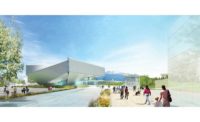Many of the largest project starts in the Mountain States ran counter to national trends last year in part because the list of new projects is dominated by government work at a time when institutional building is slowing down from less public funding. In fact, more than 20 of the year’s top 25 project starts are publicly funded.

As always, information for the annual rankings came from multiple sources, including McGraw-Hill Dodge reports and project submissions from the contractors themselves.
Topping the 2011 rankings is Denver’s FasTracks Eagle P3 project, a public-private partnership that will bring commuter rail service from downtown Denver to the airport and construct other rail lines throughout the metro area. A joint venture consortium known as the Denver Transit Partners is leading the $1.3-billion job. The project’s complex financing package includes federal grants that will allow the airport rail line to finish in 2016, coinciding with completion of a new $500-million hotel, train station and public plaza to be built on the south side of the airport terminal.
That project, known as the South Terminal Redevelopment Project, or STRP, does not appear on the 2011 starts list because, before construction could begin, the city of Denver had to reach an agreement with architect Santiago Calatrava. His firm did the initial design for the hotel and train station before pulling out of the STRP project during a budget dispute last year. The city settled its design issues with Calatrava last fall, and the STRP officially got under way this February.
Utah’s largest start of last year was a $1.2-billion data center for the National Security Agency being built at Camp Williams, south of Salt Lake City, by the Balfour Beatty/DPR/Big-D joint venture construction team. The project, which started in early 2011, encompasses 100,000 sq ft of a Tier III data center and 900,000 sq ft of technical support and administrative space. Support components include water-treatment facilities, a vehicle inspection area, interim visitor control center, perimeter site security measures, fuel storage, water storage, chiller plant, fire suppression systems and 100% electrical generator and UPS back-up capacity.
The facility will showcase innovative technology and energy-efficiency features and is designed to achieve LEED-Silver certification. KlingStubbins, Philadelphia, and Salt Lake City-based Architectural Nexus are serving as design partners to the joint-venture team. In addition to sustainable requirements, the team is maximizing the use of building information modeling.
The only other mega-project on the list is a $600-plus-million replacement hospital for the Veterans Administration being built by a Kiewit-Turner joint venture on the Fitzsimons medical campus in Aurora, Colo. After years in the planning and funding stages, the 31-acre project site will house more than 1.1 million sq ft of buildings. A 182-bed medical center will include inpatient tertiary care and ambulatory care, a 30-bed spinal cord injury/disorder center, a 30-bed nursing home community living center, a research building and above- and below-ground parking structures. All of the buildings will be topped with photovoltaic panels. The project team is seeking LEED-Silver certification.
Post-Stimulus Adjustments
But the institutional boom may be over. The data center in Utah and the new VA medical campus in Colorado are likely among the last of the large federal projects to be built in the region for the foreseeable future. The area is expecting to see a big slowdown in other publicly funded projects, especially in the highway sector. Noticeably absent from the 2011 list of top starts are the large highway projects from previous years, including Utah’s I-15 CORE, Dixie Drive Interchange and Mountain View Corridor, and the stimulus-funded bridge replacements like I-25 and Alameda in Denver. Some of those projects are still under construction, but the large bid packages of the past few years have given way to smaller ancillary projects, as all phases of work near completion.
Because of that, contractors—and especially highway and infrastructure firms—are bracing for a slowdown. Moreover, Congress has not yet passed a viable long-term transportation bill and is not likely to do so during a presidential election year. “The recessionary environment of the past few years strained not only federal, but also state and local budgets, limiting funding for traditional transportation projects,” says Tom Janssen, director of external affairs for Kiewit.
“This has put a premium on diversifying our client base—not losing track of our transportation roots—but looking for private clients who have funds available to move projects forward.” Randy Okland, president of Salt Lake City’s Okland Construction, agrees. “Much of the work over the past three years has been institutional in nature. The LDS Church, federal government, Intermountain Health Care and the State of Utah have been the big consumers of construction services.





Post a comment to this article
Report Abusive Comment